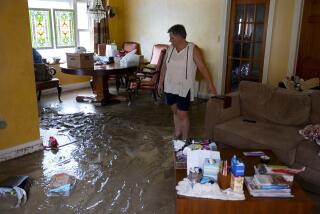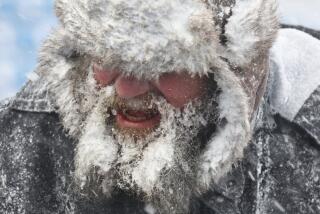Snowstorm brings early test for New York’s new mayor
- Share via
NEW YORK — On his first full day in office Thursday, Mayor Bill de Blasio faced a headache that has bedeviled many a mayor before him virtually every year: a major snowstorm.
At a news briefing shortly after swearing in his new police commissioner, former LAPD Chief William J. Bratton, De Blasio had some good news for New York. Forecasters were predicting just a few inches of snow overnight, less than first anticipated.
But east of the city, Nassau and Suffolk counties on Long Island were under a blizzard warning, as was Cape Cod in Massachusetts and some coastal areas of Maine and New Hampshire.
Boston’s mayor, Thomas M. Menino, who steps down Monday after 20 years in office, announced that schools would be closed Friday. “Extended vacation one last gift from Mayor Menino to students of Boston,” the city said in a news release.
In Connecticut, state employees were let out of work early to beat the snow home. More than 5,000 flights were canceled or delayed nationwide in anticipation of the storm, and Boston’s Logan International Airport said it would not handle any flights after 8:30 p.m. Thursday.
The Boston area is expected to get up to 14 inches of snow. This is nothing new for the city. Last year, it got 24.9 inches of snow in one February storm.
But this storm is something new for De Blasio, who campaigned on the idea that under his billionaire predecessor, Michael R. Bloomberg, New York became a “tale of two cities,” right down to the distribution of snowplows.
For De Blasio, that came into clear focus in December 2010, when a storm dumped about 20 inches of snow on the city. For three days, hundreds of thousands of New Yorkers living outside of Manhattan — including De Blasio, then the city’s public advocate — waited for plows to clear their streets.
It was a debacle for Bloomberg, who conceded that the city’s response was “inadequate and unacceptable.”
That won’t happen this time, De Blasio vowed as the temperature outside fell into the 20s and winds whipped off the rivers surrounding Manhattan.
“I went to sleep with visions of snow in my head,” said De Blasio, adding that 450 salt-spreaders and 1,700 plows were ready to cover the 6,000 miles of streets in the city’s five boroughs: Brooklyn, Queens, Bronx, Staten Island and Manhattan.
“I believe government needs to serve all five boroughs equally. That begins today,” the new mayor said.
De Blasio said he would wait perhaps until early morning before deciding whether schools should be closed Friday.
“We don’t close schools lightly,” he said, reflecting the dilemma that faces every mayor of the nation’s largest city when faced with bad weather: If schools are closed and the predicted storm fizzles, the city is accused of overreacting. If schools remain open and the storm lives up to ferocious expectations, the city is accused of failing to take adequate precautions.
“We’re talking about 1.1 million-plus kids and all of their families,” De Blasio said after meeting with the city’s emergency management team and explaining why, as of 5 p.m., he still had not made a call on the schools. “We have to make sure we get this right.”
This time, the snow threat was compounded by predictions of high winds and bitterly cold temperatures, increasing the storm’s danger. “Many areas will see temperatures 20-30 degrees below normal with record lows possible,” the National Weather Service said.
“Every storm is different,” said Steve Bellone, the Suffolk County executive. “This storm has different things that will make it treacherous — that is, those high winds and those really freezing conditions in overnight hours.”
Bellone spoke shortly after New York Gov. Andrew Cuomo announced that the Long Island Expressway, the major east-west road connecting New York City to Suffolk and Nassau counties, would be closed in both directions from midnight until at least 5 a.m. Cuomo, declaring a statewide state of emergency, also said large stretches of Interstate 85 and Interstate 87 would be closed overnight. New Jersey Gov. Chris Christie also declared a statewide state of emergency.
The Port Authority of New York and New Jersey, which operates the region’s airports, said it had no plans to close the facilities even though airlines had begun canceling flights headed into the area.
“At our airports, the goal is to work through the night, keep up with the storm and try to deliver safe … taxiways for tomorrow’s push,” said Thomas Bosco, the interim director of the Port Authority’s aviation department.
But he added: “We expect and already are anticipating widespread cancellations and delays.”
New York mayors have long struggled with how to respond to bad weather, with the most infamous case occurring in February 1969. Mayor John Lindsay was heavily criticized for leaving residents of Queens snowbound more than a week after more than 15 inches of snow fell on the city. Later that year, he lost the Republican mayoral primary, a defeat blamed largely on blizzard backlash.
De Blasio said he was not letting political considerations guide the response to his first storm as mayor.
“I don’t feel we have to get this right because of my past criticisms,” he said, alluding to his anger over the unplowed streets of 2010. “We have to get this right because I am the mayor of New York City.”
More to Read
Sign up for Essential California
The most important California stories and recommendations in your inbox every morning.
You may occasionally receive promotional content from the Los Angeles Times.












